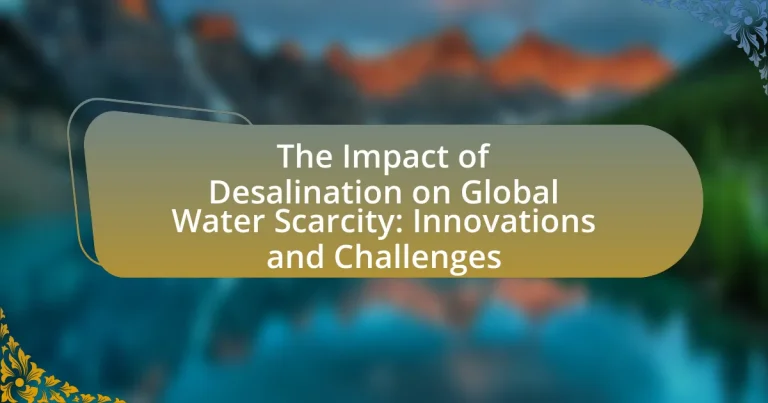Desalination is a critical technology that addresses global water scarcity by converting seawater into potable water, significantly increasing the freshwater supply, particularly in arid regions. As of 2020, over 16,000 desalination plants worldwide produced more than 100 million cubic meters of freshwater daily, with countries like Saudi Arabia and the UAE relying heavily on this technology. However, desalination poses environmental challenges, including high energy consumption and the disposal of concentrated brine, which can harm marine ecosystems. The article explores the primary methods of desalination, their effectiveness, economic factors influencing adoption, and the innovations shaping the future of this technology, while also addressing the social, political, and environmental challenges it faces.

What is the impact of desalination on global water scarcity?
Desalination significantly alleviates global water scarcity by converting seawater into potable water, thus increasing the available freshwater supply. As of 2020, desalination plants worldwide produced over 100 million cubic meters of freshwater daily, primarily benefiting arid regions with limited freshwater resources. This technology provides a reliable alternative to traditional water sources, especially in countries like Saudi Arabia and the United Arab Emirates, where over 90% of drinking water comes from desalination. However, the process also poses environmental challenges, such as high energy consumption and the disposal of concentrated brine, which can impact marine ecosystems.
How does desalination address water scarcity issues?
Desalination addresses water scarcity issues by converting seawater into freshwater, thereby increasing the available supply of potable water. This process is particularly vital in arid regions where freshwater resources are limited; for instance, countries like Saudi Arabia and the United Arab Emirates rely heavily on desalination, with over 70% of their drinking water sourced from this technology. According to the International Desalination Association, as of 2020, there were over 16,000 desalination plants worldwide, producing more than 100 million cubic meters of water per day, which significantly alleviates the pressure on traditional freshwater sources.
What are the primary methods of desalination used today?
The primary methods of desalination used today are reverse osmosis and thermal distillation. Reverse osmosis involves forcing seawater through a semi-permeable membrane that separates salt and impurities from water, making it suitable for consumption. Thermal distillation, on the other hand, utilizes heat to evaporate water, leaving salts behind, and then condenses the vapor back into liquid form. According to the International Desalination Association, as of 2020, reverse osmosis accounts for approximately 60% of the global desalination capacity, highlighting its dominance in the field.
How effective are these methods in providing potable water?
Desalination methods are highly effective in providing potable water, capable of producing millions of cubic meters of fresh water daily. For instance, reverse osmosis, a prevalent desalination technique, can achieve over 99% removal of salts and impurities, making seawater suitable for human consumption. According to the International Desalination Association, as of 2020, there were over 20,000 desalination plants worldwide, supplying approximately 300 million people with potable water. This demonstrates the significant role desalination plays in addressing global water scarcity challenges.
What are the environmental implications of desalination?
Desalination has significant environmental implications, primarily due to the discharge of concentrated brine and chemicals back into the ocean. This brine can increase salinity levels in marine ecosystems, potentially harming aquatic life. Studies indicate that brine disposal can lead to reduced biodiversity and altered habitats, as seen in areas near desalination plants where marine organisms struggle to adapt to the higher salinity. Additionally, the energy-intensive nature of desalination contributes to greenhouse gas emissions, further impacting climate change. Research from the International Desalination Association highlights that while desalination addresses water scarcity, it must be managed carefully to mitigate these environmental risks.
How does desalination affect marine ecosystems?
Desalination negatively affects marine ecosystems primarily through the discharge of brine, which is a concentrated salt solution. This brine can increase salinity levels in surrounding waters, leading to stress on marine organisms that are not adapted to higher salinity. Studies indicate that the elevated salinity can disrupt local biodiversity, particularly affecting sensitive species such as fish and invertebrates. Additionally, the intake process of desalination plants can harm marine life by entraining and killing small organisms, including larvae and plankton, which are crucial for the marine food web. Research published in the journal “Marine Pollution Bulletin” highlights that the ecological impacts of desalination are significant, with potential long-term consequences for marine biodiversity and ecosystem health.
What are the carbon footprints associated with desalination processes?
Desalination processes have significant carbon footprints primarily due to the energy-intensive nature of the technology used. The carbon emissions associated with desalination can vary widely, but studies indicate that the energy consumption for seawater reverse osmosis (SWRO) can range from 3 to 6 kilowatt-hours per cubic meter of water produced. This energy often comes from fossil fuels, contributing to greenhouse gas emissions. For instance, a report by the International Energy Agency (IEA) states that desalination accounts for approximately 0.5% of global electricity consumption, leading to an estimated annual carbon footprint of around 100 million tons of CO2. Additionally, the carbon intensity of the energy source directly impacts the overall emissions; regions relying on coal or oil for electricity will have higher carbon footprints compared to those using renewable energy sources.
What economic factors influence the adoption of desalination?
The economic factors influencing the adoption of desalination include capital investment costs, operational expenses, and the availability of alternative water sources. High initial capital investment is required for the construction of desalination plants, which can range from millions to billions of dollars depending on the technology used and the scale of the facility. Operational expenses, including energy consumption and maintenance, significantly impact the long-term viability of desalination as a water supply solution. Additionally, the presence of cheaper alternatives, such as groundwater or surface water, can deter investment in desalination. For instance, in regions where freshwater sources are abundant and inexpensive, the economic rationale for desalination diminishes, as seen in many parts of the United States where traditional water supply methods remain more cost-effective.
How do costs compare between desalination and traditional water sources?
Desalination costs are generally higher than those of traditional water sources. The average cost of desalinated water ranges from $0.50 to $3.00 per cubic meter, while traditional sources like surface water or groundwater typically cost between $0.10 and $0.50 per cubic meter. This significant difference arises from the energy-intensive processes involved in desalination, such as reverse osmosis and thermal distillation, which require substantial infrastructure and operational expenses. For instance, a study by the International Desalination Association indicates that energy costs can account for up to 50% of the total desalination cost, highlighting the economic challenges associated with this technology compared to conventional water supply methods.
What role do government policies play in desalination projects?
Government policies are crucial in shaping the development and implementation of desalination projects. These policies determine funding allocations, regulatory frameworks, and environmental standards that guide the construction and operation of desalination facilities. For instance, countries facing severe water scarcity, such as Saudi Arabia and Israel, have established supportive policies that promote investment in desalination technology, leading to significant advancements in efficiency and sustainability. Additionally, government policies can incentivize research and innovation in desalination methods, as seen in the European Union’s Horizon 2020 program, which funds projects aimed at improving water management and desalination technologies.

What innovations are shaping the future of desalination?
Innovations shaping the future of desalination include advanced membrane technologies, solar desalination, and energy-efficient processes. Advanced membrane technologies, such as graphene oxide membranes, significantly enhance water permeability and salt rejection, leading to lower energy consumption. Solar desalination utilizes solar energy to power the desalination process, making it more sustainable and cost-effective, particularly in arid regions. Energy-efficient processes, like reverse osmosis with improved energy recovery systems, reduce operational costs and environmental impact. These innovations collectively address the growing demand for freshwater in the context of global water scarcity.
How is technology advancing desalination processes?
Technology is advancing desalination processes through innovations such as reverse osmosis, solar desalination, and nanotechnology. Reverse osmosis, which uses semi-permeable membranes to separate salt from water, has seen improvements in membrane efficiency and durability, reducing energy consumption and costs. Solar desalination leverages solar energy to power the desalination process, making it more sustainable; for instance, solar stills can produce potable water at lower operational costs. Nanotechnology enhances desalination by developing advanced materials that improve filtration and reduce fouling, leading to higher water recovery rates. These advancements collectively address the growing demand for freshwater in water-scarce regions, as evidenced by the increasing number of desalination plants worldwide, which reached over 20,000 by 2020, producing more than 100 million cubic meters of water daily.
What are the latest breakthroughs in desalination technology?
Recent breakthroughs in desalination technology include the development of solar-powered desalination systems and advancements in membrane technology. Solar-powered systems utilize renewable energy to reduce operational costs and environmental impact, making desalination more sustainable. For instance, a study published in the journal “Nature Sustainability” in 2022 demonstrated that solar stills can achieve high efficiency in converting seawater to freshwater, significantly lowering energy consumption. Additionally, innovations in membrane technology, such as graphene oxide membranes, have shown the potential to increase water permeability while reducing salt rejection, as reported in research by the University of California, Berkeley, in 2023. These advancements contribute to more efficient and cost-effective desalination processes, addressing global water scarcity challenges.
How do these innovations improve efficiency and reduce costs?
Innovations in desalination technology improve efficiency and reduce costs by enhancing energy consumption and increasing water recovery rates. For instance, advancements such as reverse osmosis membranes and energy recovery devices have led to a reduction in energy use by up to 30% compared to traditional methods. Additionally, the implementation of solar desalination techniques can lower operational costs significantly, with some systems achieving cost reductions to as low as $0.50 per cubic meter of water produced. These innovations not only make desalination more economically viable but also contribute to sustainable water management in regions facing water scarcity.
What role do renewable energy sources play in desalination?
Renewable energy sources play a crucial role in desalination by providing sustainable power for the energy-intensive processes involved in converting seawater into freshwater. Utilizing solar, wind, and hydroelectric energy reduces reliance on fossil fuels, thereby lowering greenhouse gas emissions and operational costs. For instance, solar desalination technologies, such as solar stills and solar-powered reverse osmosis, harness sunlight to drive the evaporation and condensation processes, making them environmentally friendly and cost-effective. According to a study published in the journal “Desalination,” integrating renewable energy into desalination systems can decrease energy consumption by up to 50%, highlighting its effectiveness in addressing global water scarcity while promoting sustainability.
How can solar energy be integrated into desalination plants?
Solar energy can be integrated into desalination plants by utilizing photovoltaic (PV) systems or concentrating solar power (CSP) technologies to provide the necessary energy for the desalination process. PV systems convert sunlight directly into electricity, which can power reverse osmosis systems, while CSP uses mirrors to concentrate sunlight to generate heat, which can drive thermal desalination processes like multi-effect distillation or multi-stage flash distillation.
For instance, a study published in the journal “Renewable and Sustainable Energy Reviews” highlights that integrating solar energy into desalination can reduce operational costs and carbon emissions, making the process more sustainable. The research indicates that solar-powered desalination can achieve energy savings of up to 80% compared to conventional fossil fuel-based systems, demonstrating its potential effectiveness in addressing global water scarcity challenges.
What are the benefits of using wind energy for desalination?
Using wind energy for desalination offers significant benefits, primarily in terms of sustainability and cost-effectiveness. Wind energy is a renewable resource that reduces reliance on fossil fuels, thereby lowering greenhouse gas emissions associated with traditional desalination methods. For instance, a study by the International Renewable Energy Agency (IRENA) highlights that integrating wind energy into desalination processes can decrease operational costs by up to 30%, making water production more affordable. Additionally, wind-powered desalination systems can be deployed in remote coastal areas, providing fresh water to communities that lack access to traditional water sources. This approach not only addresses water scarcity but also promotes energy independence and resilience against climate change impacts.
What are the potential future trends in desalination?
Potential future trends in desalination include advancements in energy efficiency, the integration of renewable energy sources, and the development of innovative membrane technologies. Energy-efficient processes, such as reverse osmosis, are expected to reduce operational costs and environmental impact. The use of solar and wind energy in desalination plants is gaining traction, as it aligns with global sustainability goals. Additionally, research into new materials for membranes, such as graphene and biomimetic membranes, promises to enhance desalination efficiency and reduce fouling, thereby improving overall water production rates. These trends are supported by ongoing investments and research initiatives aimed at addressing global water scarcity challenges.
How might desalination technology evolve in the next decade?
Desalination technology is likely to evolve significantly in the next decade through advancements in energy efficiency, membrane technology, and integration with renewable energy sources. Innovations such as forward osmosis and solar desalination are expected to reduce operational costs and environmental impact, making desalination more accessible. For instance, the International Desalination Association reported that energy consumption in desalination processes has decreased by approximately 30% over the past decade due to improved membrane materials and processes. Furthermore, the integration of desalination plants with solar and wind energy systems can enhance sustainability, as seen in projects like the 100 MW solar desalination plant in Saudi Arabia, which aims to provide clean water while minimizing carbon emissions. These advancements will likely address global water scarcity challenges more effectively.
What are the implications of emerging technologies like nanotechnology in desalination?
Emerging technologies like nanotechnology significantly enhance desalination processes by improving efficiency and reducing costs. Nanotechnology enables the development of advanced membranes with increased permeability and selectivity, which can lead to higher water recovery rates and lower energy consumption. For instance, research has shown that nanostructured membranes can achieve salt rejection rates exceeding 99%, while traditional membranes often fall short. Additionally, the incorporation of nanoparticles can facilitate the removal of contaminants, further improving water quality. These advancements not only address the growing demand for freshwater but also contribute to sustainable water management practices in regions facing water scarcity.

What challenges does desalination face in addressing global water scarcity?
Desalination faces significant challenges in addressing global water scarcity, primarily due to high energy consumption, environmental impacts, and economic feasibility. High energy consumption is a critical issue, as desalination processes, particularly reverse osmosis, require substantial electricity, which can lead to increased greenhouse gas emissions if sourced from fossil fuels. Environmental impacts arise from the discharge of concentrated brine back into the ocean, which can harm marine ecosystems. Additionally, the economic feasibility of desalination is a challenge, as the costs associated with building and maintaining desalination plants can be prohibitive, especially for developing countries. According to the International Desalination Association, the average cost of desalinated water is significantly higher than that of traditional freshwater sources, making it less accessible for widespread use.
What are the major technical challenges in desalination?
The major technical challenges in desalination include high energy consumption, membrane fouling, and brine disposal. High energy consumption is a significant issue, as desalination processes like reverse osmosis require substantial power, often making them economically unfeasible in energy-scarce regions. Membrane fouling occurs when contaminants accumulate on the filtration membranes, reducing efficiency and increasing operational costs; studies indicate that fouling can decrease membrane lifespan by up to 50%. Brine disposal presents environmental challenges, as the concentrated salt byproduct can harm marine ecosystems if not managed properly. These challenges hinder the widespread adoption and sustainability of desalination technologies.
How do scaling and fouling affect desalination efficiency?
Scaling and fouling significantly reduce desalination efficiency by obstructing water flow and increasing energy consumption. Scaling occurs when dissolved minerals precipitate on membranes, leading to reduced permeability and increased pressure requirements. Fouling involves the accumulation of organic and inorganic materials on membrane surfaces, which further impedes water passage and necessitates more frequent cleaning or replacement of membranes. Studies indicate that scaling can decrease membrane performance by up to 50%, while fouling can lead to a 30% increase in energy costs for desalination processes. These factors collectively hinder the overall effectiveness and economic viability of desalination technologies.
What are the limitations of current desalination technologies?
Current desalination technologies face several limitations, including high energy consumption, environmental impact, and limited freshwater production efficiency. High energy consumption is a significant barrier, as processes like reverse osmosis require substantial electricity, making desalinated water expensive compared to traditional sources. For instance, energy costs can account for up to 50% of the total operational expenses in desalination plants.
Additionally, the environmental impact is notable; the discharge of concentrated brine back into the ocean can harm marine ecosystems, affecting biodiversity. Studies indicate that brine can increase salinity levels in surrounding waters, which can be detrimental to aquatic life.
Lastly, the efficiency of freshwater production is often limited by the technology used. For example, reverse osmosis typically achieves a recovery rate of only 40-60%, meaning a significant portion of the input water is not converted into usable freshwater. These limitations highlight the challenges that current desalination technologies must overcome to be more sustainable and effective in addressing global water scarcity.
What social and political challenges impact desalination projects?
Social and political challenges significantly impact desalination projects by influencing funding, public acceptance, and regulatory frameworks. For instance, public opposition often arises due to environmental concerns, as desalination can affect marine ecosystems and increase carbon emissions. Additionally, political instability in regions facing water scarcity can hinder investment and collaboration on desalination initiatives. A study by the International Desalination Association highlights that over 50% of desalination projects face delays due to regulatory hurdles and community resistance, demonstrating the critical role of social and political dynamics in the success of these projects.
How do public perceptions influence desalination initiatives?
Public perceptions significantly influence desalination initiatives by shaping policy decisions, funding allocations, and community support. When the public views desalination positively, it can lead to increased investment and faster implementation of projects, as seen in regions like California, where public support for desalination has resulted in the construction of facilities to address water scarcity. Conversely, negative perceptions, often driven by concerns about environmental impacts or costs, can hinder project development, as evidenced by opposition to desalination plants in Australia, where public skepticism delayed initiatives. Thus, public sentiment directly affects the feasibility and success of desalination efforts.
What are the geopolitical implications of desalination in water-scarce regions?
Desalination in water-scarce regions has significant geopolitical implications, primarily by altering power dynamics and resource distribution among nations. As countries invest in desalination technology, they can reduce their dependence on transboundary water sources, which may lead to decreased tensions over shared water resources. For instance, nations like Saudi Arabia and the United Arab Emirates have heavily invested in desalination, enabling them to secure water independence and enhance their regional influence. Furthermore, the technology can create economic opportunities and foster cooperation or competition among neighboring states, depending on how water resources are managed and shared. The strategic importance of desalination can also lead to geopolitical alliances or conflicts, particularly in areas where water scarcity is exacerbated by climate change and population growth.
What are the best practices for implementing desalination solutions?
The best practices for implementing desalination solutions include conducting thorough feasibility studies, selecting appropriate technology, ensuring energy efficiency, and integrating environmental impact assessments. Feasibility studies help determine the economic viability and site suitability, while selecting technology such as reverse osmosis or multi-effect distillation can optimize performance based on local conditions. Energy efficiency is crucial, as desalination processes can be energy-intensive; utilizing renewable energy sources can mitigate costs and environmental impact. Additionally, conducting environmental impact assessments ensures that the implementation does not adversely affect marine ecosystems, as evidenced by studies indicating that improper discharge of brine can harm local biodiversity.
How can stakeholders collaborate to enhance desalination efforts?
Stakeholders can collaborate to enhance desalination efforts by forming public-private partnerships that leverage resources, expertise, and technology. These collaborations can facilitate the sharing of best practices and innovations, such as energy-efficient desalination technologies, which have been shown to reduce operational costs and environmental impacts. For instance, the International Desalination Association reports that advancements in reverse osmosis technology have improved energy efficiency by up to 50% over the past decade. Additionally, stakeholders can engage in joint research initiatives to develop sustainable practices and policies that address regulatory challenges and promote investment in desalination infrastructure. By aligning their goals and resources, stakeholders can create a more integrated approach to tackling global water scarcity through enhanced desalination efforts.
What strategies can be employed to mitigate the challenges of desalination?
To mitigate the challenges of desalination, strategies such as improving energy efficiency, utilizing renewable energy sources, and enhancing membrane technology can be employed. Improving energy efficiency can significantly reduce operational costs; for instance, advancements in reverse osmosis technology have led to energy consumption reductions of up to 50% compared to older methods. Utilizing renewable energy sources, like solar or wind power, can further decrease the carbon footprint associated with desalination processes. Additionally, enhancing membrane technology, such as developing more durable and selective membranes, can improve water recovery rates and reduce fouling, thereby increasing the overall efficiency of desalination plants. These strategies collectively address the economic and environmental challenges faced in desalination, making it a more viable solution for global water scarcity.


